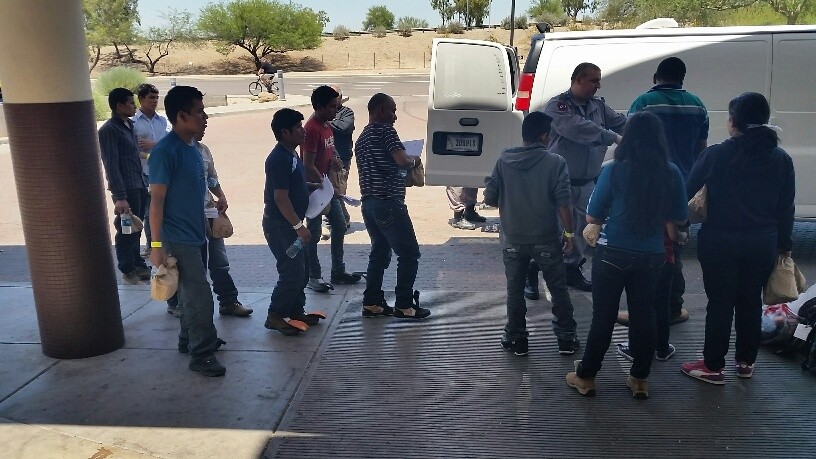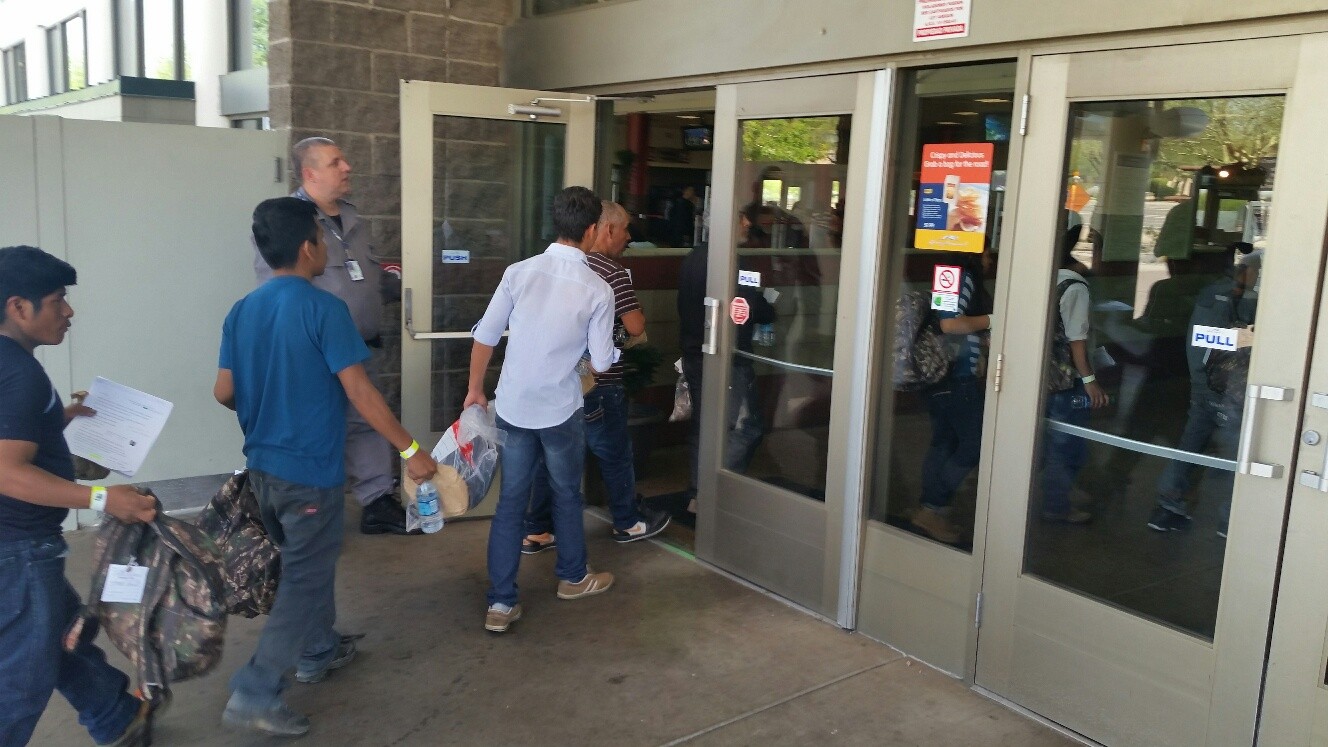Falluja refugees say Islamic State uses food to enlist fighters
Reuters: Iraqis who fled Islamic State-held Falluja as government and allied forces advanced on the city said they had survived on stale dates and the militants were using food to enlist fighters whose relatives were going hungry.
The ultra-hardline Sunni fighters have kept a close guard on food storage in the besieged city near Baghdad that they captured in January 2014, six months before they declared a caliphate across large parts of Iraq and Syria.
The militants visited families regularly after food ran short with offers of supplies for those who enlisted, said 23-year-old Hanaa Mahdi Fayadh from Sijir on the northeastern outskirts of Falluja.
“They told our neighbor they would give him a sack of flour if his son joined them; he refused and when they had gone, he fled with his family,” she said.
“We left because there was no food or wood to make fires, besides, the shelling was very close to our house.”
She and others interviewed in a school transformed into a refugee center in Garma, a town under government control east of Falluja, said they had no money to buy food from the group.
The Iraqi government stopped paying the salaries of employees there and in other cities under Islamic State control a year ago to stop the group seizing the funds.
Fayadh escaped Sijir on May 27, four days after the government offensive on Falluja began, with a group of 15 relatives and neighbors, walking through farmland brandishing white flags.
Most of the 1,500 displaced people who found refuge in the school in Garma were women and children, because the army takes men for screening over possible ties with Islamic State. Fayadh said she was waiting for news of her two brothers who were being investigated.
HUMAN SHIELDS
Prime Minister Haider al-Abadi said last week the offensive had slowed to protect tens of thousands of civilians trapped in Falluja with limited access to water, food and electricity.
Fayadh said the situation in the city was very difficult. “The only thing remaining in the few shops open was dates, old, stale dates and even those were very expensive,” she said.
Azhar Nazar Hadi, 45, said the militants had asked her family to move from Sijir into Falluja itself, a clear attempt to use them as human shields.
“We hid,” she said. “There was shooting, mortars and clashes, we stayed hidden until the forces came in” and escorted them out to the refugee center.
The militants took hundreds of people, along with their cattle, with them into Falluja, Hadi said.
“Life was difficult, very hard, especially when we stopped receiving salaries and retirement pensions.
“The last seven months we ran out of everything and had to survive on dates, and water,” she said. “Flour, rice and cooking oil were no longer available at an affordable price.”
A 50 kg (110 lb) sack of flour cost 500,000 dinars ($428.45), almost half an average Iraqi employee’s month salary.
Abadi ordered the offensive on Falluja, which lies 50 km (32 miles) west of Baghdad, after a series of bombings claimed by Islamic State hit Shi’ite districts of the capital, causing the worst death toll this year.
Between 500 and 700 militants are in Falluja, according to a U.S. military estimate. The Iranian-backed Shi’ite militia coalition that is supporting the Iraqi army offensive on the city says the number of IS fighters there is closer to 2,500.
The United Nations says about 50,000 civilians remain trapped in Falluja, which has been under siege since December, when the Iraqi army recaptured Ramadi, the capital of Anbar province to the west.
When Hadi was asked what Islamic State militants had been telling civilians in Falluja, it was her six-year old child who answered, reciting the Koranic verse: “Be patient, God is with those who are patient.”
The Iraqi Army Is Flying Chinese-Made Killer Drones
Can China’s unmanned aircraft match the U.S.-made Predator and Reaper?
PopularMechanics: Last year the Iraqi military took delivery of three Chinese CH-4 Cai Hong drones, an aircraft that, according to its creators, is better than the American MQ-1B Predator. That claim is now being put to the test as the drones carry out strikes against ISIS with bombs and laser-guided missiles.
The CH-4s are flying from Al-Hayy airbase in support of operations in Anbar province, site of Ramadi and Fallujah, where heavy fighting has been taking place. A recent Iraqi video (warning: graphic combat footage) shows four drone strikes, and claims that the drones destroyed one suicide car bomb before it could be used, two other vehicles carrying fighters, and a covered trench occupied by ISIS.
The Cai Hong-4 ( “Rainbow 4”) was developed by China Aerospace Science and Technology Corporation, the nation’s leading military drone makers. It first flew in 2011. While it bears some resemblance to the Predator, it is larger, with a wingspan of 60 feet and a maximum take-off weight of 3,000 lbs., compared to the 50-foot wingspan and 2,250 lbs. of the Predator. This gives it a payload 750 lbs. and an endurance of 38 hours, compared to 450 pounds and 24 hours for the Predator.
The CH-4s in Iraq are armed with a mixture of missiles and bombs. The laser-guided AR-1 is China’s answer to the Hellfire, but is slightly faster—it’s supersonic rather than subsonic, so it cannot be heard until it hits. The FT-9 is a 100-lb. satellite-guided bomb with a claimed accuracy of better than 15 feet. The makers deny that it relies on the American-built GPS system, so the weapons may use the Russian GLONASS or even the new Chinese Beidou navigation satellites.
The CH-4 may indeed be superior to the Predator, but the U.S. moved several years ago to production of the MQ-9 Reaper (also known as Predator B) which is more than three times the size of the original. It has a 14-hour endurance and carries almost 4,000 lbs. of bombs, making it much more like a manned aircraft in capability. In 2015 CASC unveiled the CH-5, which is closer to the Reaper in scale.
Perhaps the real test of the CH-4 will be whether it is cheap enough to be replaced every time one is lost. One of the main advantages of unmanned aircraft is losing one carries none of the political consequences of losing a pilot, so they can be flown on hazardous missions. At about $5 million a pop, the Predators were regarded as more or less expendable, something which does not apply to the $30 million Reaper.
If CASC can produce efficient, low-cost combat drones, then they may come to dominate the military market the way that DJI have dominated the civilian drone market. The U.S. may have invented drone warfare, but the field may end up being owned by someone else. And CASC are already offering small tactical drones for export.



 The OTMs are from Honduras, Colombia, El Salvador and Guatemala and Border Patrol officials say this week’s batch was in custody for a couple of days and ordered to call family members in the U.S. so they could purchase a bus ticket for their upcoming trip from Phoenix. Authorities didn’t bother checking the identity of the U.S. relatives or if they’re in the country legally, according to a Border Patrol official directly involved in the matter. American taxpayers pick up the fare for those who claim to have a “credible fear,” Border Patrol sources told JW. None of the OTMs were issued official court appearance documents, but were told to “promise” they’d show up for a hearing when notified, said federal agents with firsthand knowledge of the operation.
The OTMs are from Honduras, Colombia, El Salvador and Guatemala and Border Patrol officials say this week’s batch was in custody for a couple of days and ordered to call family members in the U.S. so they could purchase a bus ticket for their upcoming trip from Phoenix. Authorities didn’t bother checking the identity of the U.S. relatives or if they’re in the country legally, according to a Border Patrol official directly involved in the matter. American taxpayers pick up the fare for those who claim to have a “credible fear,” Border Patrol sources told JW. None of the OTMs were issued official court appearance documents, but were told to “promise” they’d show up for a hearing when notified, said federal agents with firsthand knowledge of the operation.
